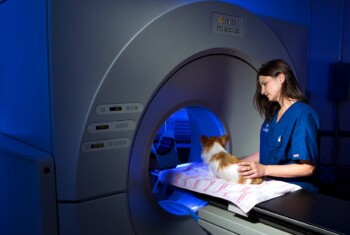Nutrition can help manage anxiety in pets and relieve worry in pet owners.
 The human-animal bond is a powerful and well-recognized phenomenon across the globe. The addition of veterinary specialization into behavioral therapy and medicine has offered owners help in resolving many behavioral issues. These unwanted behavioral problems may be due to medical causes, such as with lower urinary tract disorders. Due to the advancement of safe pharmaceutical options, behavioral modification therapies, and recently behavioral nutrition, there has been significant promise and innovative solutions in the management of pet stress and anxiety.
The human-animal bond is a powerful and well-recognized phenomenon across the globe. The addition of veterinary specialization into behavioral therapy and medicine has offered owners help in resolving many behavioral issues. These unwanted behavioral problems may be due to medical causes, such as with lower urinary tract disorders. Due to the advancement of safe pharmaceutical options, behavioral modification therapies, and recently behavioral nutrition, there has been significant promise and innovative solutions in the management of pet stress and anxiety.
Stress versus anxiety.
Stress and anxiety are not actually one in the same for our pets. Stress is the normal physiological response that occurs when fearful experiences exceed the threshold of a pet’s own self-protective coping mechanisms. Anxiety results from long-term or overwhelming stress and is characterized by undesirable behavioral and physical changes that are considered pathological. What exactly does anxiety look like in our cats and dogs? Are there different signals of stress and anxiety exhibited between our feline and canine companions? See below clinical signs that may present in cats and dogs that are experiencing anxiety.
Common anxiety-related problems.
Dogs:
- Compulsive destruction
- Excessive grooming or licking
- Fear aggression
- House soiling
- Fear of noise (thunder, etc.)
- Hiding
- Tail chasing/neurotic behaviors
- Excessive barking or whimpering
Cats:
- Inappropriate urination or defecation
- Excessive vocalization
- Destructiveness
- Aggression toward people or other animals
- Obsessive grooming
 Long-term stress and anxiety can negatively affect a cat’s or dog’s general health. They can potentiate, initiate and exacerbate physical health problems. They may also lead to a decreased quality of life, emergency crises, owner emotional distress, and, often, considerable expense to medically manage the health problem.
Long-term stress and anxiety can negatively affect a cat’s or dog’s general health. They can potentiate, initiate and exacerbate physical health problems. They may also lead to a decreased quality of life, emergency crises, owner emotional distress, and, often, considerable expense to medically manage the health problem.
The first and most important thing to do in managing these cases is to identify and treat any underlying medical conditions. For example, illness can cause anxiety if there is pain associated with that illness. It is for these reasons why it is extremely important that veterinarians and veterinary behavioral specialists perform thorough medical exams before addressing any specific behavioral problem.
Behavior therapy.
Behavioral modification is the cornerstone of all behavior therapy. And of course, there are pharmaceuticals, nutraceuticals and pheromones that can all be used as adjuncts to therapy. Nutritional management can be an important part of therapy as well. It has been shown that certain nutrients may have a calming effect on patients during times of anxiety and stress.
Alpha casozepine and L-tryptophan are two examples of nutrients that can exhibit anxiolytic effects on dogs and cats. By increasing levels of L-tryptophan in the brain, there can be an increase in serotonin. Serotonin is associated with sleep regulation, appetite, and overall calmness. Alpha casozepine is a hydrolyzed milk protein that works on a neurotransmitter, GABA, which also has been associated with calming effects and appeasement.
 There are several benefits to adding a nutritional component to the management plan of cats and dogs needing behavioral therapy. For example, if specific nutrients are added to a pet food, then it may help avoid the need for medication in some patients. It may also help relieve the stress of pilling on both the owner and the pet.
There are several benefits to adding a nutritional component to the management plan of cats and dogs needing behavioral therapy. For example, if specific nutrients are added to a pet food, then it may help avoid the need for medication in some patients. It may also help relieve the stress of pilling on both the owner and the pet.
In addition, in general the pet food is more readily available, has a high margin of safety and negates the need for the hassle of daily supplementation. The next time a cat or dog presents with clinical signs of stress or anxiety, consider how nutrition may help manage these patients and even relieve some added stress or anxiety of the pet owner.
Please talk to your local Royal Canin Representative to find out more.


